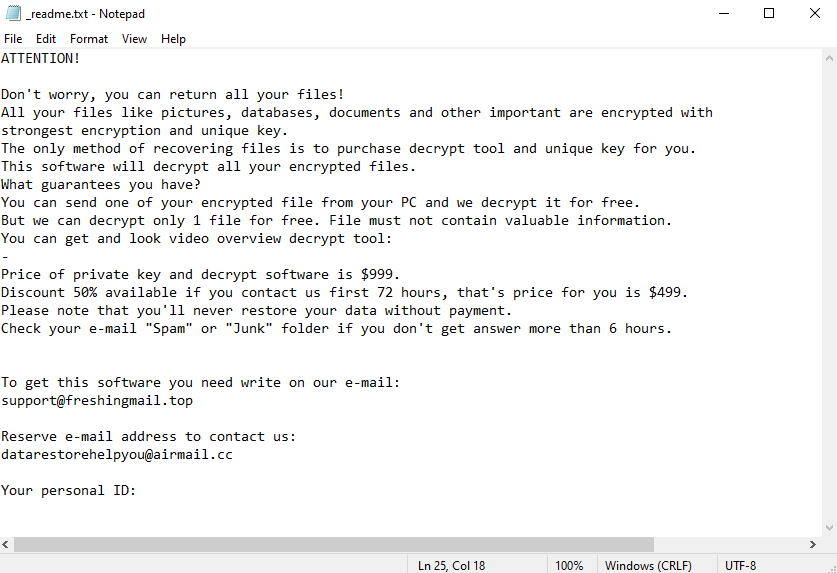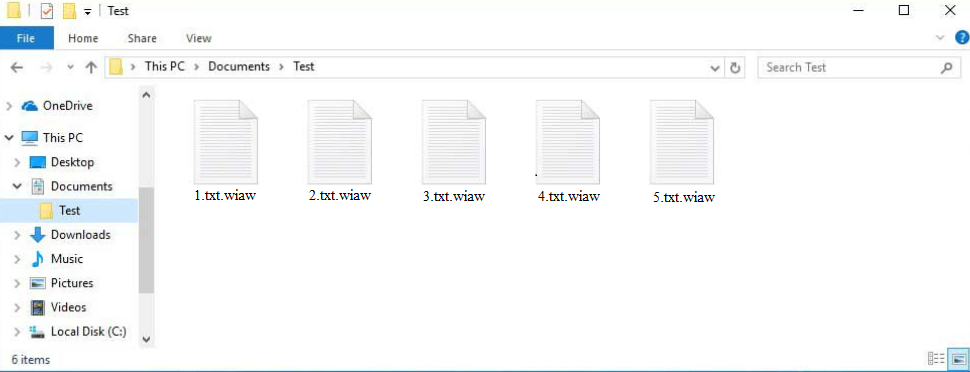Delete Wiaw ransomware
Wiaw ransomware is malware that encrypts files. It’s part of the Djvu/STOP ransomware family that is operated by a notorious group of cyber criminals. The ransomware targets personal files and essentially takes them hostage. Encrypted files are not always recoverable, which is why ransomware is such a dangerous infection.
When malicious files are initiated, the ransomware immediately starts encrypting files. The main targets of ransomware are personal files, including documents, videos, and photos. Encrypted files are immediately noticeable because of the extension added to them. This particular ransomware adds .wiaw. For example, an encrypted 1.txt file would become 1.txt.wiaw. Files with that extension will not be openable unless they’re first decrypted.
All ransowmare from the Djvu/STOP malware family drop more or less identical _readme.txt ransom notes. The only things that seem change are the contact email addresses and the ransom amount. The _readme.txt ransom note explains that files have been encrypted and cannot be recovered unless users agree to pay $999 for a decryptor. There’s supposedly a 50% discount for users who contact the ransomware operators but whether that is true or not, it’s not recommended to pay the ransom. The note also claims that one file can be recovered for free as long as it does not contain any important information but we do not recommend contacting cybercriminals. Ransomware is operated by malicious actors, and there’s nothing forcing them to help victims even after they pay. Furthermore, the money users pay goes toward future malicious activities.
ATTENTION!
Don’t worry, you can return all your files!
All your files like pictures, databases, documents and other important are encrypted with strongest encryption and unique key.
The only method of recovering files is to purchase decrypt tool and unique key for you.
This software will decrypt all your encrypted files.
What guarantees you have?
You can send one of your encrypted file from your PC and we decrypt it for free.
But we can decrypt only 1 file for free. File must not contain valuable information.
You can get and look video overview decrypt tool:
–
Price of private key and decrypt software is $999.
Discount 50% available if you contact us first 72 hours, that’s price for you is $499.
Please note that you’ll never restore your data without payment.
Check your e-mail “Spam” or “Junk” folder if you don’t get answer more than 6 hours.To get this software you need write on our e-mail:
support@freshingmail.topReserve e-mail address to contact us:
datarestorehelpyou@airmail.ccYour personal ID:
For users who have a backup, file recovery should be very easy. However, before accessing the backup, it’s important to first delete Wiaw ransomware from the computer. Anti-malware should be used for Wiaw ransomware removal because it’s a complicated infection. When the ransomware is no longer detected in scans, users can access their backups.
If users do not have a backup, file recovery will be much more difficult, if not impossible. The only way to recover files would be to use a free Wiaw ransomware decryptor, which will not necessarily be released. So if users are out of options, they should back up their encrypted files and store them safely until a free Wiaw ransomware decryptor becomes available.
Ransomware distribution methods
Ransomware that does not target specific users is very generic and is distributed through email attachments, torrents, malicious ads/links, etc. If users have poor browsing habits (e.g. they open unsolicited email attachments without doublechecking them, use torrents to pirate copyrighted content, etc.), they are at an increased risk of infecting their computers with something malicious. A great way to prevent many infections is to develop better online habits and become familiar with malware distribution methods.
Email attachments are one of the most common ways malware is distributed. The emails are often disguised as parcel delivery notifications or order notifications. In most cases, users who receive these emails have had their email addresses leaked. Senders often claim that important documents that need to be reviewed are attached to emails, and this creates a sense of urgency that pressures users to open the attachments. If users open the attachments, they infect their computers.
Malware distribution emails are very generic most of the time. First of all, they are often full of grammar/spelling mistakes. Since mistakes are very rare in legitimate emails, especially automatic ones, this is very easy to notice in malicious emails. Another sign is users being addressed using generic words like User, Member, Customer, etc., instead of senders using their names. Users’ names are always used in emails by companies whose services they use. However, since malicious actors target many users with the same email, they use generic greetings.
In some cases, particularly when someone is a specific target, malicious emails can be much more sophisticated. This is why it’s recommended to always scan unsolicited email attachments with anti-malware software or VirusTotal before opening them.
Torrents are also often used to distribute malware. Many torrent sites are poorly moderated, which allows malicious actors to upload torrents with malware in them. In most cases, torrents for entertainment content like movies, TV series, and video games are likely to contain malware. Using torrents to pirate copyrighted content is highly discouraged because it’s not only content theft but it’s also dangerous for users’ computers and data.
How to remove Wiaw ransomware
Ransomware is a very complicated infection and requires a professional anti-malware program. It’s not recommended to try to remove Wiaw ransomware manually because users could end up causing additional damage to their computers. If users have a backup, they can access it and start recovering files as soon as they remove Wiaw ransomware from their computers. Ransomware must be no longer present when users connect to a backup because the ransomware would just encrypt the backed-up files otherwise.
If users do not have a backup, their only option is to back up the encrypted files and wait for a free Wiaw ransomware decryptor to be released. Whether one will be released is not certain because ransomware from this family is complex. However, if it does become available, it will be released on NoMoreRansom. If a free Wiaw ransomware decryptor cannot be found on NoMoreRansom, it’s unlikely to be available anywhere else. Users should also be aware that there are many fake decryptors, using which would lead to additional malware infections.
Wiaw ransomware is also detected as:
- Win32:PWSX-gen [Trj] by AVG/Avast
- Gen:Variant.Fragtor.515893 by BitDefender
- Trojan.MalPack.GS by Malwarebytes
- Trojan:HTML/Redirector.PAN!MTB by Microsoft
- A Variant Of Win32/Kryptik.HWLT by ESET
- HEUR:Trojan.Win32.Agent.gen by Kaspersky
Site Disclaimer
WiperSoft.com is not sponsored, affiliated, linked to or owned by malware developers or distributors that are referred to in this article. The article does NOT endorse or promote malicious programs. The intention behind it is to present useful information that will help users to detect and eliminate malware from their computer by using WiperSoft and/or the manual removal guide.
The article should only be used for educational purposes. If you follow the instructions provided in the article, you agree to be bound by this disclaimer. We do not guarantee that the article will aid you in completely removing the malware from your PC. Malicious programs are constantly developing, which is why it is not always easy or possible to clean the computer by using only the manual removal guide.



